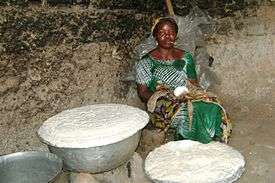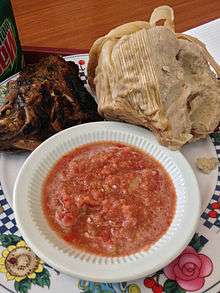Kenkey
 Woman preparing Fante kenkey (boiled maize dough) | |
| Alternative names | kɔmi pronounced (kormi), |
|---|---|
| Type | Dumpling |
| Place of origin | Ga people , Ghana |
| Main ingredients | Ground corn |

Kenkey or kormi or kokoe or dorkunu is a staple dish similar to sourdough dumpling from the Ga-inhabited regions of West Africa, usually served with pepper sauce and fried fish or soup, stew. Areas where kenkey is eaten are Ghana, eastern Côte d'Ivoire, Togo, western Benin, Guyana (where it is known as "konkee"), and Jamaica. It is usually made from ground corn (maize), like sadza and ugali. It is also known in Jamaica as dokunoo, dokono, dokunu (the Asante refer to the same dish as dɔkono), blue drawers, and tie-a-leaf. In Trinidad it is called "paime" (pronounced pay-me) and differs in that it does not contain plantain but may include pumpkin and coconut. In the cuisine of the Caribbean, it is made with cornmeal, plantain, green banana, sweet potato (Asante and Jamaican version, which came from the Asante version) or cassava, wrapped in banana leaves. The food is derived from African cooking traditions.[1][2]
Unlike ugali, making kenkey involves letting the maize ferment before cooking. Therefore, preparation takes a few days in order to let the dough ferment. After fermentation, the kenkey is partially cooked, wrapped in banana leaves, corn husks, or foil, and steamed.[3] There are several versions of kenkey, such as Ga and Fante kenkey. The Ga kenkey is more widespread in most parts of Ghana.
Ingredients
- 6–8 cups of cornflour or cornmeal (ground corn or ground maize). (White cornmeal is preferred, and it should be finely ground, like flour. Latin American-style cornflour, as is used in tortillas, tamales, pupusas, etc., is the right kind.)
- Banana leaves, or maize or corn husks, or aluminum foil to wrap dough in (the leaves or husks may be available at African, Asian, or Latino groceries)
Preparation
Fermented cornmeal dough
Traditional method
In a large container combine the cornflour (or cornflour and grated cassava) with just enough warm water to dampen all of it. Mix well. Cover the container with a clean cloth. Set it in a warm place, such as a warmed oven or on top of the refrigerator, for two to three days or more for best results. Fermentation may take longer than two days, especially in cool climates. (Note: a warmed oven is an oven that has been heated for a few minutes and turned off. The flour should ferment, not cook). When it is properly fermented, it should have a slightly sour, but not unpleasant, aroma, like rising bread dough. Overly fermented cornflour will not taste right.
Alternate method
Prepare the cornflour as described above, and let it ferment for about six hours. Then mix one tablespoon of vinegar into the wet cornflour.
Soak the dry corn in water. After three days, drain and wash the corn in fresh water. Grind it and add some water to make it into a dough with a smooth surface. Keep it in a warm place to ferment for two to three days before using it to prepare the kenkey. Before using it for the preparation, the moldy surface on top should be removed and discarded.
- Knead the fermented dough with your hands until it is thoroughly mixed.
- In a large pot, bring one cup of water to a boil. Slowly add one part of the fermented dough. Cook for about 10 minutes, stirring constantly and vigorously. Remove from heat. This half of the dough is called the "aflata".
- Combine the aflata with the remaining uncooked dough. Mix well. The proportion of raw dough to the aflata determines the softness of the kenkey after cooking.
- Divide the aflata and raw dough mixture into serving-sized pieces. Wrap the pieces tightly in banana leaves, maize or corn husks, or foil. Banana leaves are more flexible if they have been briefly warmed in a hot oven or a pot of boiling water. The wrapped dough should look like burritos or tamales. Cooking string can be used to tie the wrapping closed.
- Place the wrapped dough packets on a wire rack above water in a large pot. Bring to a boil and steam for one to three hours, depending on their size and thickness. Serve at room-temperature.
- Ga kenkey is usually served hot with red pepper sauce made of ground chili pepper, onions and tomatoes, as well as a black pepper sauce locally called shito.
- Fante kenkey is usually served warm with tomato gravy or palaver sauce. It may also go with any fish, poultry, or meat dish from Western Africa. In Ghana, guests are often served Fante kenkey with red pepper sauce and canned sardines or fried fish, especially if they have arrived unannounced or after the family's evening meals.
The water in which the kenkey is boiled serves as a drink when maize or corn husks are used as the wrapper for cooking the kenkey. This water is called "otinshi nu".
Note: Ready-to-use fermented cornmeal dough made especially for banku and kenkey may be available at African grocery stores and should be prepared according to package instructions.
See also
References
- ↑ Jamaican Cooking: 140 Roadside and Homestyle Recipes.
- ↑ "Regional Dishes". touringghana. Archived from the original on 10 August 2013. Retrieved 9 August 2013.
- ↑ "KENKEY". Ghanaweb. Retrieved 9 August 2013.
- Phil Bartle, "Kwasi Bruni; Corn and the Europeans", VCN.org.
- "West Africa Recipe - Cooking Kenkey". West Africa Secondary School, Accra, Ghana. PBS Kids.
- "Questions and Answers > Food products > What is kenkey and how is it made?". Food-info.net. Wageningen University, The Netherlands.
- Fran Osseo-Asare (March 28, 2007). "Ghana-style Kenkey". Betumi.com.
- "Studies on kenkey : a food product made from corn in Ghana"
- "Paime: a traditional dessert", Daily Express (Trinidad & Tobago), 3 September 2010.